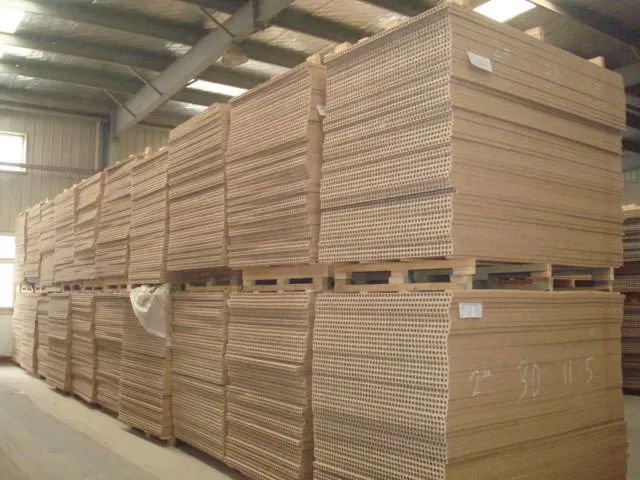
In 2019 the past year has been
an extremely difficult year for China’s
foreign trade in timber and products, as
well as a year of opportunities and
challenges. Due to the decline in
exports and the impact of domestic The
reduction in the use of raw materials
such as fiberboard, particleboard, and
the tax imposed by China on the import
of hardwood from the United States has
affected the import of wood and
wood-based panels.
In addition, due to the shrinking
international forest product market and
fierce competition in the forest product
market, China's exports of wood
processing products such as medium and
high-density fiberboard, solid wood
composite flooring and wooden furniture
have declined.
However, 2019 is the most extraordinary
year in the history of China’s
development. After GDP reached RMB 99.09
trillion, the process of urbanization
has accelerated, a large number of
people have been lifted out of poverty
and new jobs have been created. The
impact of wood and wooden furniture
Increasing demand for wood products,
coupled with China's continued cessation
of natural forest logging, has provided
a market for the import of wood and
related wood processing products.
Last year, the total value of China's
timber and wood products trade was
56.172 billion U.S. dollars, a decrease
of 12.11% over the previous year; among
them, the import value was 22.983
billion U.S. dollars, a year-on-year
decrease of 12.06%; the export value was
33.189 billion U.S. dollars, a
year-on-year decrease of 12.14%.
Import side
1. Import of timber and processed
products
Due to the reduction in the use of
wood and wood-based panels in wooden
furniture, and China's additional
tariffs on imported hardwood timber
from the United States, the amount
of wood imported from the United
States has been greatly reduced,
which will affect imports in 2019.
(1) Timber imports
1. Log import
As China continues to stop logging
of natural forests, coupled with
China’s accelerated urbanization
process, a large number of people
lifted out of poverty, and new jobs,
the demand for wood has increased.
However, since June 1 last year, the
import of hardwood timber from the
United States After the levy of
tariffs, many wood processing
companies reduced imports from the
United States, resulting in a
significant reduction in China's
imports of wood from the United
States last year.
For example, the import of logs from
the United States last year only
completed 3,693,600 cubic meters, a
decrease of 41% compared with the
previous year, and the reduction
reached 2.55 million cubic meters.
Together with the decline in the
output of wooden furniture, the
growth rate of log imports was
eased. Log imports were completed in
2019. 59,806,900 cubic meters, an
increase of only 0.1% over the
previous year, but the growth rate
decreased by 7 percentage points.
After China imposed tariffs on
hardwood timber, the number of logs
imported from the United States
dropped from the third place in
China's log imports to the fifth
place. The top 5 countries in terms
of log imports from China are: New
Zealand, Germany, the Russian
Federation, Australia and the Czech
Republic.
2. Import of sawn timber
The tariffs imposed on hardwood
imports from the United States last
year not only affected the import of
logs, but also had a greater impact
on the imports of sawn timber. For
example, for companies importing oak
from the United States, for example,
in addition to 25% tariffs, 15% %
VAT on sawn timber.
In this way, many wood processing
companies reduced their imports from
the United States, resulting in a
substantial reduction in wood
imports from the United States last
year. For example, the United States
saw only 1,765,800 cubic meters of
sawn timber last year, a decrease of
39.03% from the previous year, and
the reduction reached 1,130,300
cubic meters.
Because American wood is an
important source of high-quality
wood in China, it has a great impact
on Chinese wooden furniture. In
2019, the import of sawn timber was
38,083,600 cubic meters, an increase
of only 3.58% over the previous
year. The top 5 countries in terms
of China's sawn timber imports are
Russia, Canada, Thailand, the United
States and Finland.
(2) Import of wood-based panels
1. Imports of plywood have
increased significantly
Due to the rapid development of
China's plywood, the wood used is
generally of finer diameter, which
affects the quality of plywood.
Therefore, plywood, solid wood
composite flooring and templates
must be imported from Russia and
other countries to meet the needs of
production and life.
In 2019, the imported plywood was
202,400 cubic meters, an increase of
24.15% over the previous year. The
top five countries for plywood
imports are Vietnam, Russia,
Thailand, Malaysia and Tanzania.

2. Imported fiberboard
In order to meet the needs of
laminate flooring production, China
still has to import some medium and
high-density fiberboards. In 2019,
the import volume was 257,900 cubic
meters, a decrease of 5.15% from the
previous year.
The top five countries in the middle
and high-density fiberboard imports
are Germany, New Zealand, Australia,
Switzerland and Indonesia.
3. Imported particleboard
Due to the decline in the output of
wooden furniture last year, the
demand for board types such as
particleboard decreased, and imports
were completed at 962,100 cubic
meters, a decrease of 2.72% over the
previous year. The top five import
countries are Romania, Thailand,
Malaysia, Brazil and Canada.
(3) Import of wooden furniture
With the improvement of people’s
living standards, there is still a
market for wooden furniture in Italy
and other countries in China.
However, due to the impact of real
estate, the import of wooden
furniture in 2019 was 7,453,900
pieces, a decrease of 15.89% from
the previous year, and the import
amount was US$766 million. A
decrease of 17.01% over the previous
year.

Wood processing products export
Due to the shrinking of the
international market for wood
processing products, some Southeast
Asian companies such as Vietnam have
seized the market at low prices.
Competition in the international
market is fierce, making China's
exports of wood furniture, medium
and high-density fiberboard and
solid wood composite flooring
encounter unprecedented
difficulties.
Export side
1. Export of wood-based panels
(1) Plywood export
In recent years, China's plywood has
developed rapidly. Due to
overcapacity, many products have to
look for foreign markets. However,
in recent years, the international
plywood market has shrunk and
competition is fierce. The United
States was once China's largest
export market for plywood.
However, they have continuously
suppressed Chinese products; they
have raised the import threshold and
restricted some products that do not
meet the mandatory standards for
formaldehyde emissions in the United
States. In addition, the United
States’ anti-dumping tax rate on
parquet flooring has reached 13.74%,
an increase of 9.03 over the past.
Percentage points, which has a great
impact on China's solid wood
composite flooring exports.
Therefore, the export volume of
plywood to the United States
(including parquet) has been
declining for several consecutive
years after the anti-dumping tax on
parquet. In 2019, it has retreated
from China's largest plywood
exporter to the fifth exporter
position. Therefore, the export of
China's plywood and solid wood
composite flooring is very
difficult. The top five countries
for plywood export are as follows:
Philippines, Vietnam, Japan, UAE and
the United States.
In 2019, China's plywood exports
completed 10.55 million cubic
meters, a decrease of 11.33% over
the previous year.
(2) Exports of medium and high
density fiberboards declined
In recent years, after laminate
flooring has been identified as
"toxic flooring" by the United
States, the international market for
medium and high-density fiberboard
and laminate flooring has been
severely affected. It is really a
fire in the city, causing fish
ponds. Due to the impact of laminate
flooring, the export volume of
traditional exporting countries all
declined in 2019. Under the passive
situation of low medium and
high-density fiberboard exports,
after looking for export markets in
an all-round way, certain
performance was still achieved. The
export volume of density fiberboard
was 2,336,900 cubic meters, a
decrease of 8.34% over the previous
year.
The top five countries for
fiberboard exports are Nigeria, the
United States, Vietnam, Canada and
the UAE.
(3) Export of particleboard
As China's particleboard production
lines continue to increase, the
output of high-quality particleboard
has also continued to increase.
However, in recent years, China's
particleboard production capacity
has been surplus. Therefore, many
particleboard companies are looking
for export markets. In 2019, China's
particleboard export volume was
316,400 cubic meters, down 4.36%
from the previous year.
The top five countries and regions:
Mongolia, Taiwan, United Arab
Emirates, South Korea and Saudi
Arabia.
2. Export of wooden furniture
The United States is the most
important export market for China's
wooden furniture. In recent years,
some companies in Southeast Asian
countries such as Vietnam have
seized the U.S. market at low
prices, which has caused a
continuous decline in the number and
value of Chinese wooden furniture
exported to the United States. For
example, in 2019, the export volume
fell by 10.02% on the basis of a 13%
drop in the previous year. What is
more serious is that the amount of
wooden furniture exported to the
United States dropped by 33.69%
compared with the previous year,
which made China’s largest wooden
furniture export market suffer.
Serious impact.

Under the passive situation of the
sluggish export of traditional
wooden furniture, we have tried
every means to find the market and
strengthened our exports to
countries along the Belt and Road
and Hong Kong. We still achieved
good results. For example, our
exports to Hong Kong, Singapore,
Malaysia, etc. have been well
received. Effect.
In 2019, the export volume of wooden
furniture completed a total of
241,509,100 pieces, a decrease of
10.44% from the previous year. Among
them, the United States completed
81,803,900 pieces, a decrease of
10.02% from the previous year,
accounting for 33.87% of China's
wooden furniture exports; the total
amount of wooden furniture exports
was completed 11.632 billion U.S.
dollars, a decrease of 13.95% over
the previous year, of which the
United States completed 3.776
billion U.S. dollars, a decrease of
33.69% over the previous year,
accounting for 32.46% of the export
value of wooden furniture.
In the past year, as China continued
to implement the cessation of
natural forest logging, accelerated
urbanization, a large number of
people lifted out of poverty and new
jobs, etc., this has increased the
consumption of wood and related
products, and provided for the
import of wood and related products
in China. The market.
However, China imposed tariffs on
imports of hardwood timber from the
United States, which affected the
import volume of high-end timber
from the United States. The export
of wood processed products, due to
the shrinking international wood
processed product market and the
establishment of various economic
barriers in some developed
countries, continues to suppress
China's wood processed product
trade.
In addition, Vietnam and other
countries have adopted various
preferential policies for the wood
processing industry to attract many
Chinese wood processing companies,
especially Taiwan-funded companies
to move into Vietnam, and their
wooden furniture has seized the
international market at low prices,
especially the American furniture
market. China's exports of wooden
furniture, etc. cause difficulties.
Source: Global wood trade network